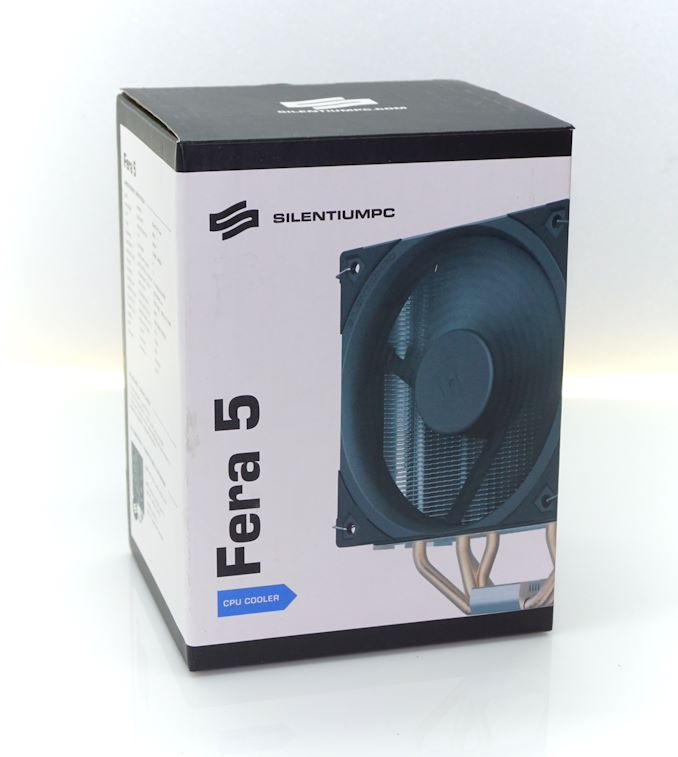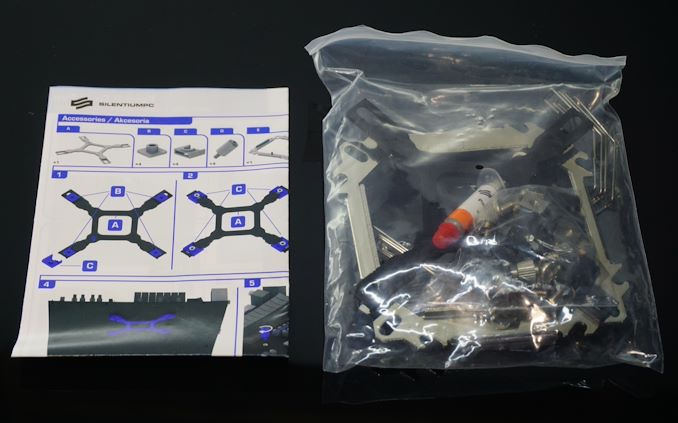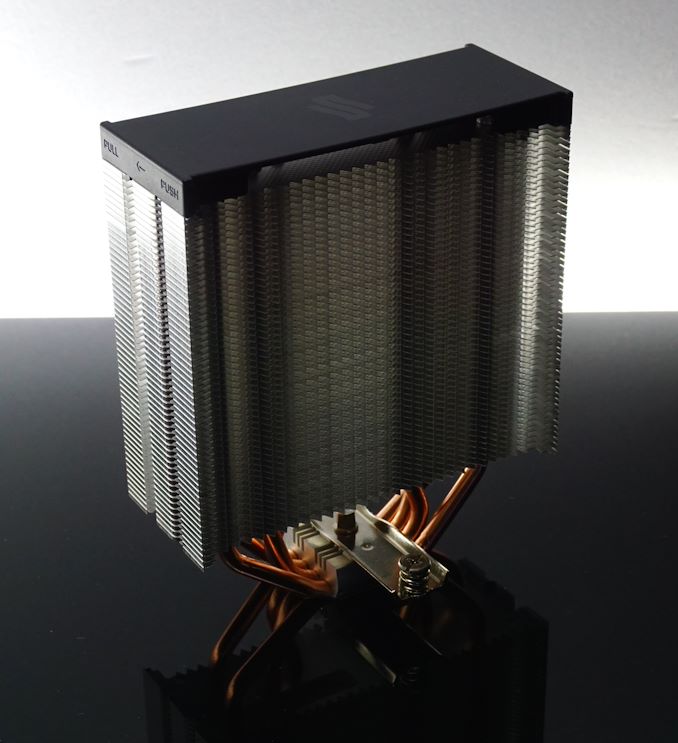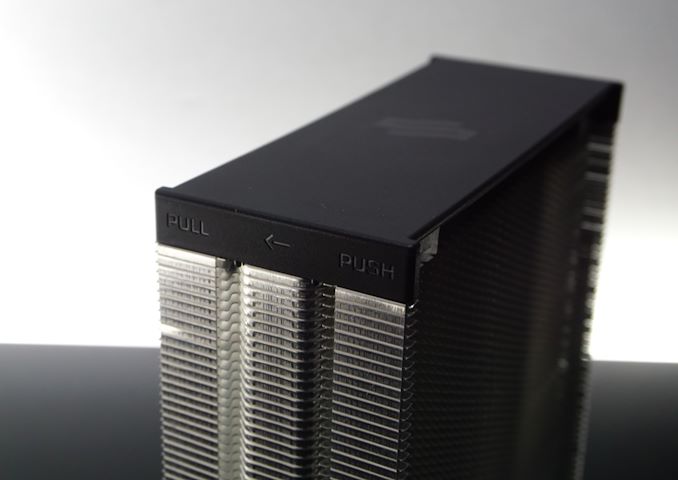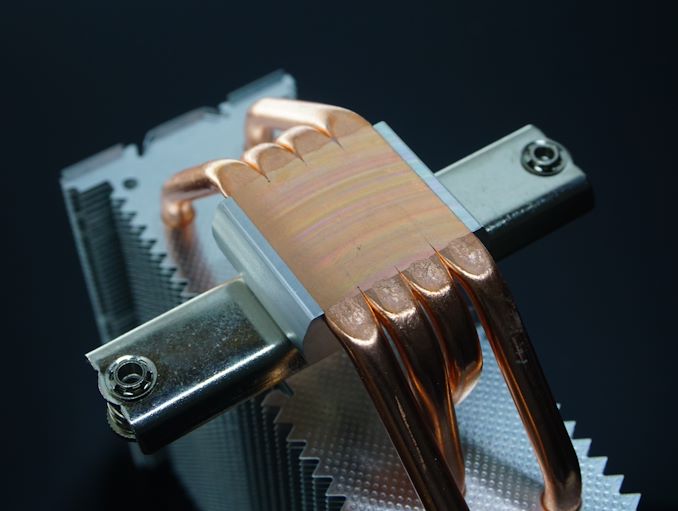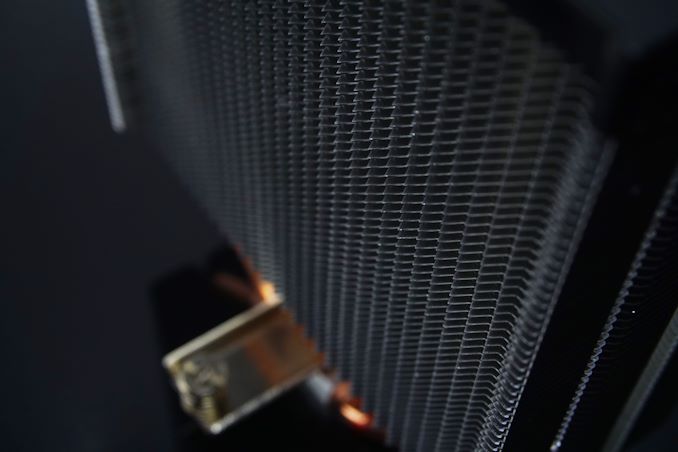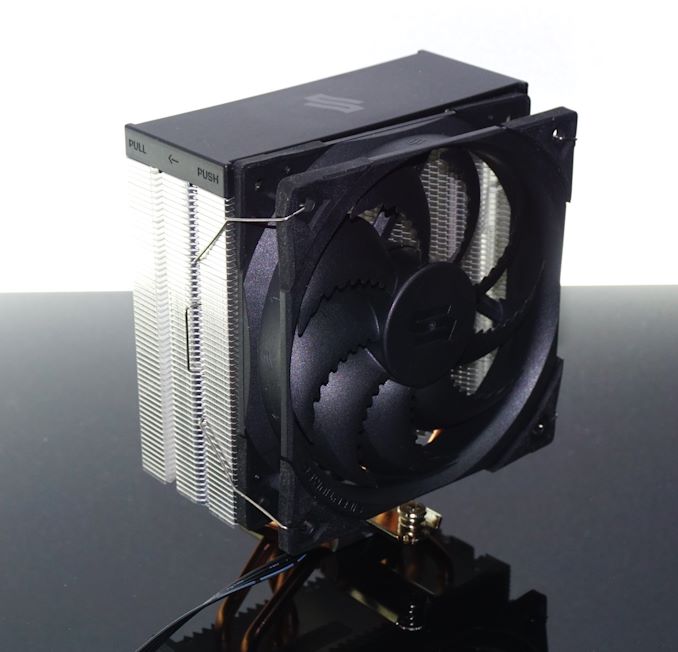
Original Link: https://www.anandtech.com/show/17389/the-silentiumpc-fera-5-cpu-cooler-review-quiet-cooling-on-a-budget
The SilentiumPC Fera 5 CPU Cooler Review: Quiet Cooling on a Budget
by E. Fylladitakis on May 17, 2022 8:00 AM EST- Posted in
- Cases/Cooling/PSUs
- Cooler
- SilentiumPC
- CPU cooler
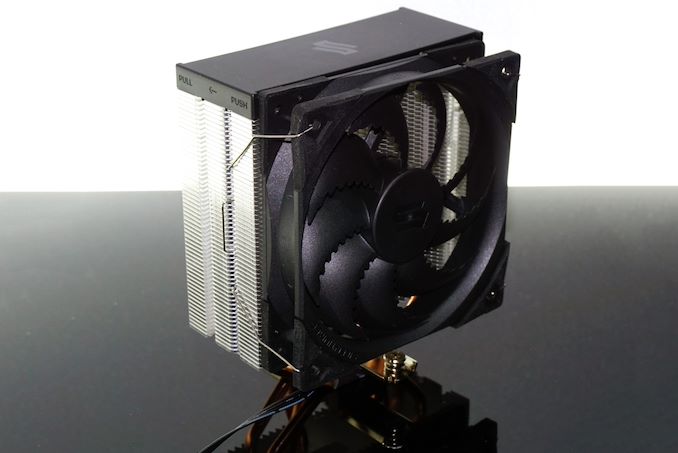
Stock cooling solutions seldom satisfy an advanced PC user, even if the system is not intended for heavy workloads or overclocked. While stock coolers are perfectly adequate for their intended purpose, often they simply are too loud or the user is uncomfortable with the operating temperature of the system. On the other hand, as fancy as huge air coolers and liquid cooling solutions may be, it is an indisputable truth that the bulk of the market consists of users that are driven by a limited budget, and thus seeking cost-effective, practical solutions.
In today’s review, we are taking a look at the Fera 5 tower CPU cooler from SilentiumPC. SilentiumPC is a Polish company that was founded in 2007, modestly marketing just a few case fans at the time. The company grew significantly over the past decade and now they have a noteworthy range of PC cooling and power products, which allowed them to establish a significant presence in the European and UK markets.
SilentiumPC's main focus is to design and produce products with a very good price-to-performance ratio – which is to say, budget products for the mainstream market. They do have a few high-end designs, but the company is much more strongly focused on the high-volume (and highly competitive) mainstream market. The Fera 5 CPU cooler that we are putting to the test in this review embodies the company’s ideals, with SilentiumPC listing great features for a cooler that sells for around €30.
Packaging & Bundle
We received the Fera 5 CPU cooler inside a simple cardboard box with limited artwork on it. Its walls are thin and flimsy but the cooler is very lightweight, so it should provide adequate shipping protection. A picture of the cooler itself decorates the front side of the box. Plenty of information regarding the cooler is printed on all sides of the box.
As expected from a product of this price range, the company supplies only the fundamental parts required to mount and operate the cooler. Inside the box, we found only the mounting hardware, a syringe with plenty of thermal grease for multiple applications, and illustrated mounting instructions.
The SilentiumPC Fera 5 CPU Cooler
The SilentiumPC Fera 5 is a standard single tower cooler, with four copper heatpipes transferring the thermal energy from the tiny base to the aluminum fin array. It is 155 mm (6.1-inches) tall, requiring at least a standard ATX case to fit. The design of the Fera 5 is rather straightforward, with the plastic top cover being virtually the only highlight that makes it stand out from the crowd.
Close inspection of the cooler’s fins reveals a saw tooth edge. This is a common practice for designers nowadays as it is a proven method to slightly reduce noise. The fins are pressed on the heatpipes and feel a little flimsy, but we find the mechanical strength of the cooler to be adequate overall. Airflow directions are engraved on the plastic cover of the cooler.
Flipping the cooler upside-down reveals the direct contact heatpipe design. This means that the heatpipes come in direct contact with the CPU shim and the aluminum part of the base exists only for the mechanical cohesion of the construct. The 6 mm heatpipes are not plated and surface corrosion may darken them over time.
The contact surface is not machined down to a perfect mirror finish but it is very smooth and flat. What is important to note, however, is that the contact surface is very small – a mere 27 mm long and wide. That is smaller than the vast majority of CPU heatspeaders, but we can declare it borderline acceptable for socket 11xx/12xx and AM4 processors, as the dies are entirely within a 27mm x 27 mm area. Meanwhile LGA 1700 is a bit trickier; the chip package is bigger, but the current Alder Lake silicon is only ~20.5 mm in its longest direction, so it fits within the bounds of the Fera 5. Past that, while it's difficult to imagine Intel making a 27 mm tall consumer die, there's certainly space in LGA 1700 to do so.
Ultimately, the Fera 5's base is big enough for all current consumer CPUs. But we would not recommend trying to fit the cooler on a CPU with a larger die than that.
SilentiumPC includes a single Fluctus 120 PWM fan with the Fera 5, or two identical fans with the dual fan version. It is a Fluid-Dynamic Bearing (FDB) engine fan of very good quality, with its blades modified so as to minimize turbulence noise. The company claims that this is a high-pressure fan, designed for highly restrictive applications. They do not release actual test figures but the multi-blade design of the fan suggests that this is a product balanced between airflow and pressure, not designed for maximum static pressure.
Testing Methodology
Although the testing of a cooler appears to be a simple task, that could not be much further from the truth. Proper thermal testing cannot be performed with a cooler mounted on a single chip, for multiple reasons. Some of these reasons include the instability of the thermal load and the inability to fully control and or monitor it, as well as the inaccuracy of the chip-integrated sensors. It is also impossible to compare results taken on different chips, let alone entirely different systems, which is a great problem when testing computer coolers, as the hardware changes every several months. Finally, testing a cooler on a typical system prevents the tester from assessing the most vital characteristic of a cooler, its absolute thermal resistance.
The absolute thermal resistance defines the absolute performance of a heatsink by indicating the temperature rise per unit of power, in our case in degrees Celsius per Watt (°C/W). In layman's terms, if the thermal resistance of a heatsink is known, the user can assess the highest possible temperature rise of a chip over ambient by simply multiplying the maximum thermal design power (TDP) rating of the chip with it. Extracting the absolute thermal resistance of a cooler however is no simple task, as the load has to be perfectly even, steady and variable, as the thermal resistance also varies depending on the magnitude of the thermal load. Therefore, even if it would be possible to assess the thermal resistance of a cooler while it is mounted on a working chip, it would not suffice, as a large change of the thermal load can yield much different results.
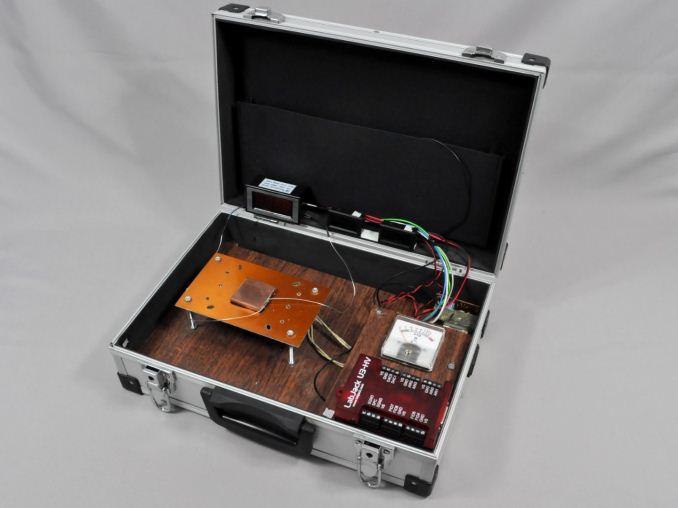
Appropriate thermal testing requires the creation of a proper testing station and the use of laboratory-grade equipment. Therefore, we created a thermal testing platform with a fully controllable thermal energy source that may be used to test any kind of cooler, regardless of its design and or compatibility. The thermal cartridge inside the core of our testing station can have its power adjusted between 60 W and 340 W, in 2 W increments (and it never throttles). Furthermore, monitoring and logging of the testing process via software minimizes the possibility of human errors during testing. A multifunction data acquisition module (DAQ) is responsible for the automatic or the manual control of the testing equipment, the acquisition of the ambient and the in-core temperatures via PT100 sensors, the logging of the test results and the mathematical extraction of performance figures.
Finally, as noise measurements are a bit tricky, their measurement is being performed manually. Fans can have significant variations in speed from their rated values, thus their actual speed during the thermal testing is being recorded via a laser tachometer. The fans (and pumps, when applicable) are being powered via an adjustable, fanless desktop DC power supply and noise measurements are being taken 1 meter away from the cooler, in a straight line ahead from its fan engine. At this point we should also note that the Decibel scale is logarithmic, which means that roughly every 3 dB(A) the sound pressure doubles. Therefore, the difference of sound pressure between 30 dB(A) and 60 dB(A) is not "twice as much" but nearly a thousand times greater. The table below should help you cross-reference our test results with real-life situations.
The noise floor of our recording equipment is 30.2-30.4 dB(A), which represents a medium-sized room without any active noise sources. All of our acoustic testing takes place during night hours, minimizing the possibility of external disruptions.
| <35dB(A) | Virtually inaudible |
| 35-38dB(A) | Very quiet (whisper-slight humming) |
| 38-40dB(A) | Quiet (relatively comfortable - humming) |
| 40-44dB(A) | Normal (humming noise, above comfortable for a large % of users) |
| 44-47dB(A)* | Loud* (strong aerodynamic noise) |
| 47-50dB(A) | Very loud (strong whining noise) |
| 50-54dB(A) | Extremely loud (painfully distracting for the vast majority of users) |
| >54dB(A) | Intolerable for home/office use, special applications only. |
*noise levels above this are not suggested for daily use
Testing Results, Maximum Fan Speed
To begin with, we are having a look at the Fera 5 with the Fluctus 120 mm fan running at its maximum speed.
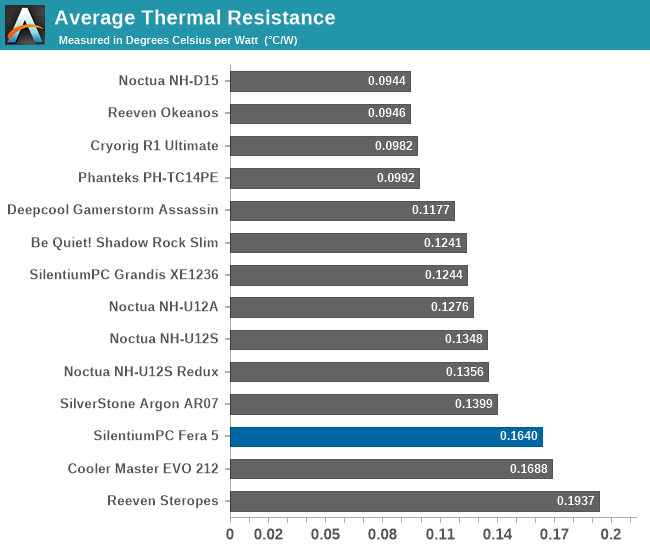
Despite its compact proportions, the SilentiumPC Fera 5 performs surprisingly well when it has to dissipate low to medium thermal loads. The average thermal resistance of 0.1640 °C/W is about what we'd expect for a mainstream cooler, with the direct heatpipe design giving the Fera 5 an edge when having to cope with low loads. This, in turn, also allows it to rival the performance of much larger and more expensive products at those low loads. However, if the thermal load is high, the cooler is betrayed by its low mass and falls far behind most tower coolers.

| Core Temperature, Constant Thermal Load (Max Fan Speed) |
SilentiumPC is strongly focused on delivering good acoustics and the Fera 5 performs exceptionally well in that aspect. Although the Fluctus 120 mm fan is clearly audible when running at its maximum speed, the noise pressure figures are relatively low and should not bother the vast majority of users.
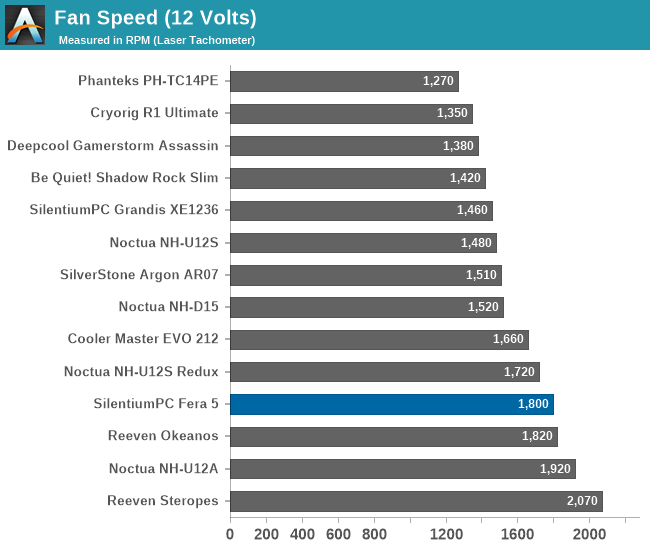

Testing Results, Low Fan Speed
Switching things up a bit, let's next take a look at cooler performance with the Fluctus 120 mm fan taken down to half speed.

Reducing the speed of the fan to about 900 RPM, the Fera 5 performs equally well regardless of the thermal load, suggesting that the low mass of the cooler strongly benefits from the high airflow of the fan when possible. When the speed of the fan is reduced, the thermal performance of the Fera 5 is mediocre but does not fall much behind other similarly sized coolers.
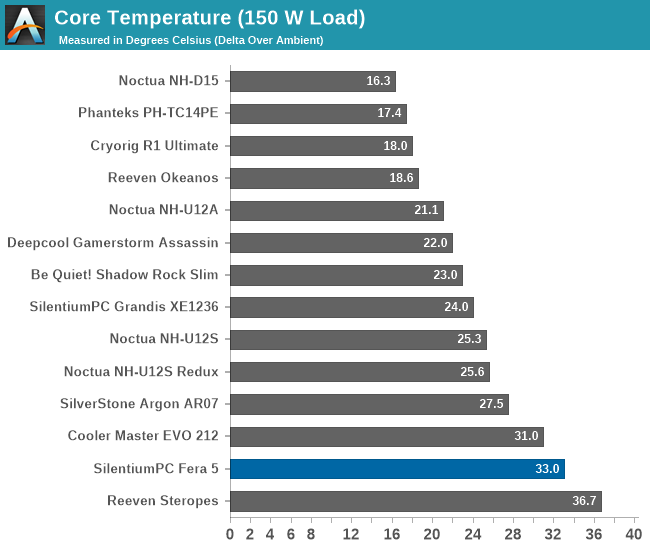
| Core Temperature, Constant Thermal Load (Low Fan Speed) |
According to the specifications of the Fluctus fan, its speed can be reduced far below 900 RPM – down to 300 RPM, if needed. Regardless, this feels redundant, as the Fera 5 is practically inaudible with the fan running even at 900 RPM. Reducing its speed further would only harm the thermal performance of the cooler without much, if any, acoustic performance gain.
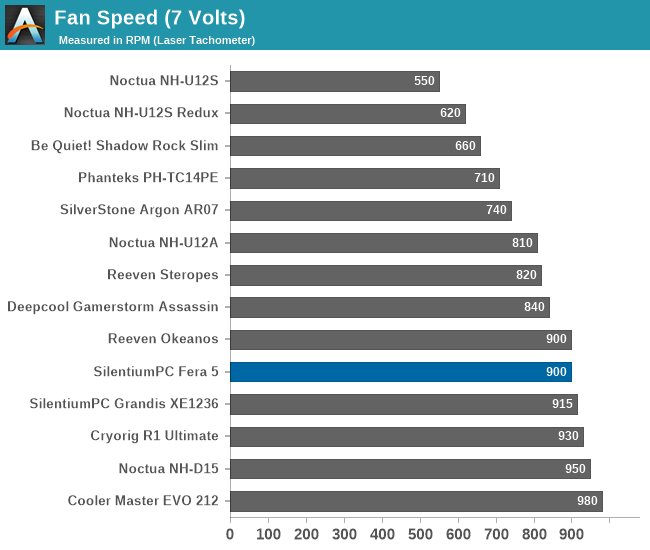
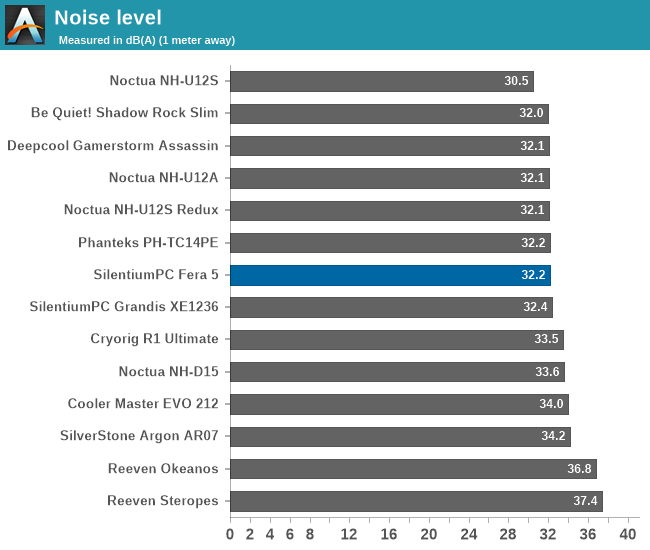
Thermal Resistance VS Sound Pressure Level
During our thermal resistance vs. sound pressure level test, we maintain a steady 100W thermal load and assess the overall performance of the coolers by taking multiple temperature and sound pressure level readings within the operating range of the stock cooling fans. The result is a graph that depicts the absolute thermal resistance of the cooler in comparison to the noise generated. For both the sound pressure level and absolute thermal resistance readings, lower figures are better.
The above chart reveals the actual strength of the SilentiumPC Fera 5. Even though its thermal performance figures are not impressive on their own, the cooler produces very low noise to achieve them. Ultimately, the Fera 5 outperforms other popular mainstream coolers, such as the Cooler Master 212. Other similarly priced coolers, such as the SilverStone AR07, can outperform it but, for the most part, the noise figures are higher. Only premium and/or significantly larger CPU coolers can outclass the Fera 5 across the board.
Conclusion
SilentiumPC is a company whose designs are driven by just two decisive factors – cost-effectiveness and low noise. The company’s ideology is to satisfy the majority of mainstream PC builders who are content with a budget-priced product that is good enough for the task. Air coolers are a difficult product to hit the sweet spot in that market, mostly because the price differences often are negligible in comparison to the value of the whole system. However, if a company manages to hit that sweet spot, their product can sell in high volumes for many years to come.
At first sight, the performance of the SilentiumPC Fera 5 seems unimpressive. While it does perform better than a stock air cooler, the Fera 5 seems barely able to compete with tried and true designs that are now a decade old. The average thermal resistance of 0.1640 °C/W is right on par with the venerable Hyper 212, a cooler that was released in 2012, and is worse than what many top-tier coolers can do with their fans dialed down.
However, when we take into account the acoustic performance, the performance boards shift dramatically. The noise output of the SilentiumPC Fera 5 cooler is very low, even with its fan running at maximum speed, allowing the cooler to deliver good thermal performance with minimal noise. This was made obvious via our Thermal Resistance VS Sound Pressure Level test, which revealed at the Fera 5 delivered very good thermal performance per acoustic dB(A).
The high inclination of the curve suggests that adding more airflow would help the Fera 5 to eventually reach the performance of much more expensive coolers, such as the Noctua NH-U12A. With SilentiumPC marketing a dual-fan version of the Fera 5 for just $8 more, choosing the dual-fan version probably seems alluring.
Looking to satisfy our curiosity, we went ahead and tested a dual-fan configuration– and to our surprise we found is that adding a second fan to the Fera 5 actually worsens the overall performance of the cooler, shifting the curve to the right significantly. A substantial amount of noise is added by the second fan, but the thermal performance gain is negligible. The Fera 5 simply does not have the mass and/or the surface area to significantly benefit from very high airflow. In that respect the sole fan that ships with it is a good counterpart for what the heatsink itself is capable of.
SilentiumPC designed the Fera 5 to entice advanced users who want a good tower cooler for their new gaming system and/or workstation but, at the same time, are on a limited budget. With street pricing running at around €30, it's a very tempting price for those in the market for a silent CPU cooler that will do more than just get the job done. Alas, the global instability during the past couple of years significantly limited the availability of many products, with the smaller companies facing the brunt of the crisis. As a result, the Fera 5 is virtually limited to Europe – and even then it's not exactly an equal distribution. Still, for those markets that have access to it, the SilentiumPC Fera 5 is a very sensible choice for users that want a budget cooler that offers a lot of bang for the buck and do not expect to be upgrading their CPU/motherboard combo anytime soon.

